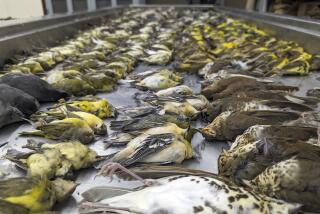Selenium at Toxic Levels Found at 2nd Fowl Habitat
- Share via
LOS BANOS, Calif. — A new federal study says toxic levels of the mineral selenium--higher than those found in birds at Kesterson National Wildlife Refuge--have been found in birds nesting at the Grassland Water District, a large collection of duck clubs in the western San Joaquin Valley.
The federal Fish and Wildlife Service study reinforces an earlier theory that selenium contamination affects migratory waterfowl habitats throughout a large part of the San Joaquin Valley.
“These levels were high enough to assume that we had a nesting problem in the Grasslands,” said Fred Paveglio, a federal wildlife biologist.
51,000 Acres
And the problem covers a much larger area. Kesterson marshes cover 1,280 acres, but Grassland stretches over 51,000 acres.
Tests of livers of gadwalls, teals and mallards show selenium levels higher than in the same species in Kesterson in 1983, Paveglio said. Those high selenium levels have been blamed for grotesque deformities in Kesterson hatchlings--twisted wings, swollen heads and missing eyes.
Like Kesterson, the Grassland District used farm drainage water containing selenium and other minerals to flood marshes for winter bird habitat, home to an estimated 250,000 migratory waterfowl. The presence of selenium at Grassland is not new, and since 1985 marshes have been flooded with fresh water in an attempt to dilute high selenium levels.
The federal study examined birds collected in 1985 and 1986 and shows the selenium concentrations remained high even after the marshes were flooded with fresh water in 1985. Paveglio said some species showed four times as much selenium in February, 1986, as during the preceding fall despite the fresh water being poured into marshes during the winter.
Naturally Occurring Mineral
Selenium is a naturally occurring mineral that can cause birth defects and other chronic health problems in very small doses. But trace amounts of selenium are needed for healthy growth in humans and other animals.
The problem probably is not confined to Grassland since the marshes are along the Pacific Flyway, a migratory route for birds in western North America. Paveglio said other birds could suffer selenium poisoning depending upon how early in the summer they nested and if birds were able to rid their bodies of accumulated selenium.
More to Read
Sign up for Essential California
The most important California stories and recommendations in your inbox every morning.
You may occasionally receive promotional content from the Los Angeles Times.













